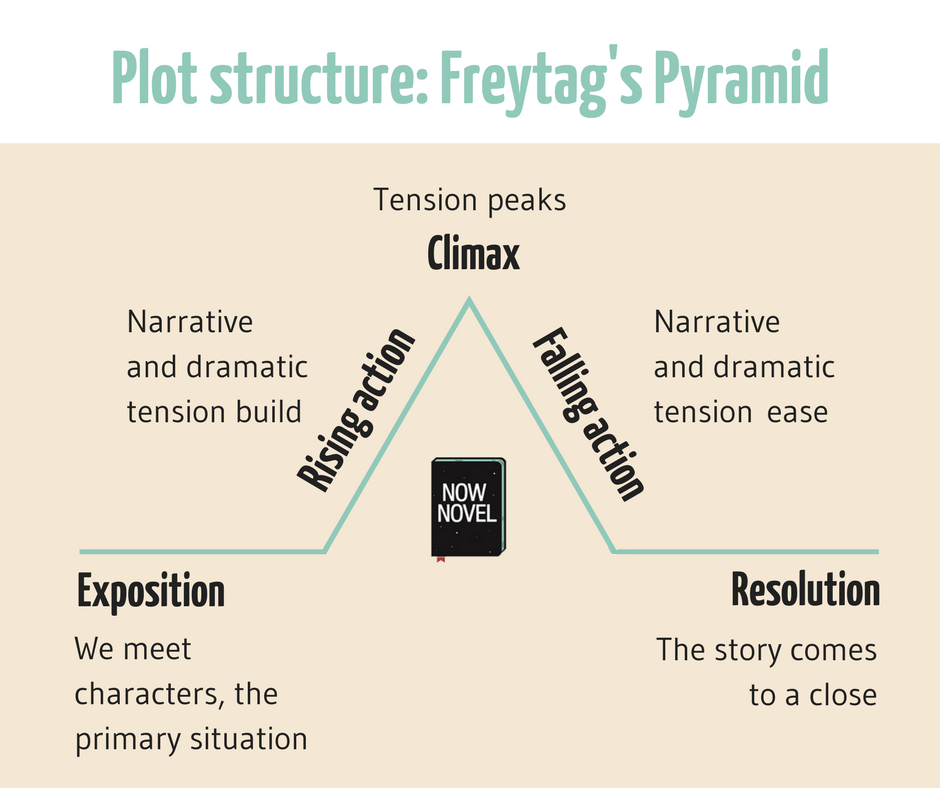Sometimes you get half way through a story or novel before you realize that your plot is missing something. Maybe it plods and meanders, or there is a sameness of tension and pace. These 7 strategies will help you make a plot more captivating:
1: Vary the intensity of rising and falling action
2: Learn how to make plot unpredictable using reversals
3: Place ordinary characters in extraordinary situations (and vice versa)
4: Use flashbacks or foreshadowing
5: Hone and trim scene beginnings and endings
6: Construct multiple story conflicts
7: Revise until every paragraph contributes to the story
Let's explore each of these ways to improve plot further:
1: Vary the intensity of rising and falling action
The 'rising action' of a novel is the section of the story after the exposition that builds the story's primary (and secondary) conflicts, advancing the plot.
This contrasts with 'falling action', the events that come after a story's climax, leading towards a resolution.
This idea of story structure was formalized by the Nineteenth Century novelist Gustav Freytag in his narrative theory study Die Technik des Dramas. 'Freytag's Pyramid' is still widely referenced, and illustrates how the ups and downs of stories are welded together.
The basic plot diagram looks like this:

Great plots don't necessarily build on a single track to a single, grand peak of conflict or suspense, though. They don't simply decrease tension and conflict step by step to a resolution either. Within individual chapters and scenes, there are passages of increasing and decreasing tension. This diagram might describe the large-scale structure of many stories. Yet on a micro level, there is more variation in intensity.
The graph for a story with interesting plot peaks and dips could look something like this:

The final book of Tolkien's Lord of the Rings cycle, The Return of the King, gives good examples of how to vary rising and falling action in unlikely places.
At the end of the book, the Hobbits finally return to the Shire having completed their primary quest (disposing of the powerful One Ring). Far from finding the peace they've fought so hard for, however, they find the Shire in ruins.
Instead of winding down post- major climax, Tolkien introduces new tensions. Under the self-serving leadership of Lotho Sackville-Baggins, the Shire has begun industrializing. This process, however, has brought environmental destruction and conflict, not an improved way of life, to the Hobbits. Tolkien knows how to structure a longer arc, and individual scenes, equally well. [To structure your own scenes effectively, download our free guide to scene structure here.]
Tolkien makes the falling action and denouement or resolution of The Return of the King have its own rising action. This allows him to sustain narrative tension and surprise right to his story cycle's end.
Similarly, vary rising and falling action to create surprise and additional story tension. Like Tolkien, strike a balance between the comfort of knowing what comes next and the pleasure of surprise.
2: Learn how to make plot unpredictable using reversals
Captivating plots often reverse the apparent trajectory of the story when we least expect it. The example above from the end of The Return of the King illustrates this. Just when we think the Hobbits can finally relax, they return to the Shire to find their once-peaceful homeland in chaos.
A 'plot reversal' is an event in a story where everything changes quickly. The paternal revelation in the Star Wars movie series, for example, makes the protagonist Luke Skywalker reassess everything he knows (Nathan Bransford summarizes other significant reversals in Star Wars here).
Plot reversals that increase story tension include:
- Reversals in relationships (for example, a character uncovers a secret or betrayal that causes them to question their closest relationships)
- Reversals in goals or plans (a sudden obstacle in a central character's path arises, requiring new solutions. Example: The forest of brambles the prince discovers on his path to the princess in the fairy tale Sleeping Beauty)
The old saying 'life happens when you're making other plans' is the logic that drives reversals. A plot doesn't grip us when we see its every turn from miles away. Plot life's 'other plans' for your characters to avoid making their paths to their goals too easy.
3: Place ordinary characters in extraordinary situations (and vice versa)
Accountant Tim gets out of bed, brushes his teeth and goes to work. This isn't, by itself, an interesting plot. There's no tension, surprise, or question begging to be asked.
If Tim shows up to work and is arrested for dealing drugs, we have a more interesting plot scenario. This unusual situation makes us ask all kinds of questions, such as:
- Why would a man with a well-paying job make money via illegal, dangerous means?
- Do the police have the right man?
- On what grounds is Tim a suspect?
Many great stories (and characters) have one of two elements: An ordinary character is roped into extraordinary circumstances, or an extraordinary person faces regular circumstances.
If you think about the classic superhero story, superheroes combine both elements. We see 'Average Joe' Clark Kent attempting to blend into ordinary society, hiding his Superman alter ego. We also see the reverse, when Superman contributes his extraordinary abilities to solving ordinary society's challenges.
The contrast between the simple character and an unusual scenario (or an unusual character and a mundane scenario) is a recipe for an intriguing plot. Characters outside of their comfort or safety zones are fascinating.
4: Use flashbacks or foreshadowing
Flashbacks aren't relevant or logical for every story. Yet when they are useful - particularly in stories involving secrets and lies, memories and mistaken beliefs - they create intrigue.
Via a flashback, you can show the reader a teasing, perplexing situation that foreshadows what the plot will still reveal in detail. Take the AMC TV series, Breaking Bad, for example. Mild-mannered chemistry teacher Walter White turns to manufacturing methamphetamine to secure a future for his family, after learning he has terminal cancer.
At the start of the series, the viewer sees scenes of White's classroom juxtaposed with scenes of his drug-lord life. These flashbacks (or 'flash forwards', since they show what will later transpire) create intrigue and give us a teasing taste of the drama that will still unfold.
Flashbacks are difficult to use well: Read this guide to avoid common pitfalls.
5: Hone and trim scene beginnings and endings
Journalists and creative writers alike are often taught to cut the first line, or even first paragraph, from their writing. You might not need to apply this as a rule. Yet this reminds us that the start of a scene or story is often 'warming up' time. To trim a scene beginning:
- Cut unnecessary info: Instead of the main character dialing a number, give readers the character on the other end of the call's first answering line
- Eliminate filter words: Instead of 'He saw that the building was on fire,' write 'The blaze had grown fierce: Smoke poured from every exit.' Don't show what is happening at one remove: Show it directly
- Get to the core action, the reason for the scene without excessive preamble
Similarly, a taut plot has endings that:
- Feel directed. Make the reader ask 'Where is this going?' not 'when will this story start to move?'
- Raise questions. Make readers ask 'Why?' (Or who, what, where or when) For Tolkien's surprise ending in The Return of the King, we ask 'Who has caused this destruction? Why? When did things start sliding downhill for the Shire?
6: Construct multiple story conflicts
Conflict in a story is a key ingredient for intrigue. When characters hold opposing goals, we enjoy the suspense and tension that result. We want to know who (or what) triumphs in the conflict. To make you plot more interesting use multiple, different types of conflict.
In Zora Neale Hurston's novel Their Eyes were Watching God (1937), for example, there are multiple interesting conflicts. We see person vs person conflict in the protagonist Janie's first marriage to Logan Killicks. Killicks treats Janie more as a domestic helper than a spouse and equal, and this leads to internal conflict, with Janie eventually deciding to leave him.
Hurston keeps her plot interesting by introducing other conflicts. For example, in the second half of the book, we see character vs environment conflict when a devastating hurricane has dire consequences for Janie and her new lover, Vergible Woods. Each of these conflicts creates its own tension and rising and falling action, keeping the story evolving and multiplying the challenges Janie faces.
7: Revise until every paragraph contributes to the story
The truth is that few plots appear on the page full formed and captivating on first pass. The first draft of a book is simply a chance to tell a whole story, from start to finish. When you revise, cut the dead weight from each chapter. Make every paragraph contribute either revealing character description or dialogue, deepening setting or character motivations that guide your story from exposition to denouement.
Do you need help revising a draft and polishing your plot? Get constructive feedback from other writers on Now Novel, or work with a writing coach to polish your story to publishable status.










Thanks this helps a lot
Marissa - Almost 8 years ago
Glad to hear that, Marissa. Thank you for reading!
Bridget At Now Novel - Almost 8 years ago
ooo
Jharna Israni - About 4 years ago